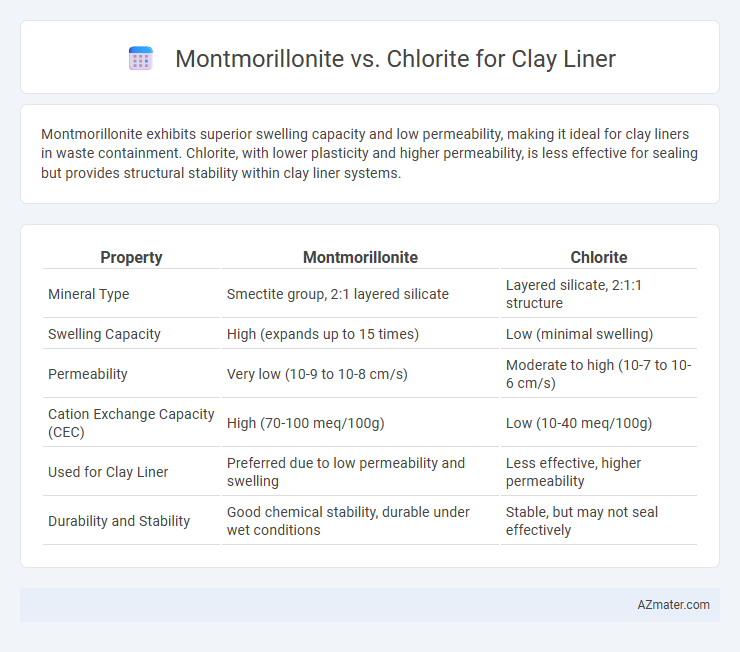Montmorillonite exhibits superior swelling capacity and low permeability, making it ideal for clay liners in waste containment. Chlorite, with lower plasticity and higher permeability, is less effective for sealing but provides structural stability within clay liner systems.
Table of Comparison
| Property | Montmorillonite | Chlorite |
|---|---|---|
| Mineral Type | Smectite group, 2:1 layered silicate | Layered silicate, 2:1:1 structure |
| Swelling Capacity | High (expands up to 15 times) | Low (minimal swelling) |
| Permeability | Very low (10-9 to 10-8 cm/s) | Moderate to high (10-7 to 10-6 cm/s) |
| Cation Exchange Capacity (CEC) | High (70-100 meq/100g) | Low (10-40 meq/100g) |
| Used for Clay Liner | Preferred due to low permeability and swelling | Less effective, higher permeability |
| Durability and Stability | Good chemical stability, durable under wet conditions | Stable, but may not seal effectively |
Introduction to Clay Liners
Clay liners are critical components in environmental containment systems due to their low permeability and high sorption capacity. Montmorillonite, a type of smectite clay, is favored for clay liners because of its exceptional swelling properties and ability to form a dense, impermeable barrier. Chlorite, while less expansive and with lower cation exchange capacity, offers greater mineral stability and durability, influencing liner performance depending on site-specific conditions.
What is Montmorillonite?
Montmorillonite is a highly absorbent clay mineral characterized by its swelling properties and significant cation exchange capacity, making it ideal for clay liners in waste containment applications. Compared to chlorite, which has lower swelling potential and less permeability reduction, montmorillonite forms a more effective barrier to fluid migration due to its ability to expand and seal voids. Its layered silicate structure allows for superior retention of water and contaminants, enhancing the overall performance of engineered clay liners.
What is Chlorite?
Chlorite is a group of greenish clay minerals primarily composed of magnesium, iron, and aluminum silicates, often found in low-grade metamorphic rocks. Unlike Montmorillonite, which exhibits high swelling capacity essential for impermeable clay liners, Chlorite has lower plasticity and reduced swelling potential, impacting its effectiveness in containment applications. Its crystalline structure and limited cation exchange capacity result in less favorable hydraulic conductivity, making Montmorillonite the preferred choice for engineered clay liners.
Physical Properties Comparison
Montmorillonite exhibits high swelling capacity and low permeability, making it ideal for clay liners requiring effective sealing properties. Chlorite has a lower swelling potential and higher permeability, which can reduce its effectiveness as a hydraulic barrier in liner applications. The fine particle size and high cation exchange capacity of montmorillonite enhance its ability to retain contaminants compared to chlorite's coarser texture and lower plasticity.
Chemical Stability and Reactivity
Montmorillonite exhibits high chemical stability and low reactivity, making it an excellent choice for clay liners in waste containment due to its ability to maintain structural integrity under varying pH and contaminant conditions. Chlorite, while also stable, has a comparatively higher chemical reactivity, which can lead to changes in mineral structure and reduced effectiveness as a barrier when exposed to aggressive chemical environments. The superior cation exchange capacity and swelling properties of montmorillonite enhance its chemical stability, promoting long-term performance in landfill liners and preventing leakage.
Hydraulic Conductivity of Montmorillonite vs Chlorite
Montmorillonite exhibits significantly lower hydraulic conductivity than chlorite, making it more effective as a clay liner for preventing fluid migration. Its expansive lattice structure allows for higher water absorption and swelling, thereby reducing permeability to values typically around 1x10^-9 m/s or lower. In contrast, chlorite's relatively rigid, non-expansive structure results in higher hydraulic conductivity, often exceeding 1x10^-8 m/s, limiting its efficiency in contaminant containment applications.
Swelling Capacity Differences
Montmorillonite exhibits significantly higher swelling capacity compared to chlorite, with montmorillonite expanding up to 15-30 times its dry volume when hydrated, making it highly effective for clay liners in preventing fluid migration. Chlorite, characterized by its limited swelling ability due to its non-expandable 2:1 layer structure, typically swells less than 5% upon hydration, resulting in lower sealing performance. The superior swelling properties of montmorillonite enhance its suitability for engineered barriers in waste containment and landfill liners where impermeability is critical.
Durability Under Environmental Conditions
Montmorillonite clay liners exhibit superior swelling capacity and self-sealing properties, enhancing durability under fluctuating moisture and chemical exposure compared to chlorite, which has a lower plasticity and reduced ability to maintain impermeability. Chlorite's crystalline structure makes it more resistant to mechanical weathering but less effective in sealing cracks caused by environmental stressors. Montmorillonite's layered silicate structure allows it to absorb contaminants and maintain structural integrity, making it the preferred choice for long-term containment in variable environmental conditions.
Cost and Availability for Clay Liners
Montmorillonite clay, prized for its high swelling capacity and low permeability, tends to be more expensive and less widely available compared to chlorite clay, making it a costlier choice for clay liners. Chlorite, often found abundantly in many regions, offers a more economical alternative but may require larger quantities to achieve similar impermeability due to its lower swelling potential. The choice between montmorillonite and chlorite for clay liners hinges on balancing budget constraints with availability and the specific engineering requirements of the containment project.
Conclusion: Choosing the Right Clay for Liners
Montmorillonite clay offers superior swelling capacity and low permeability, making it highly effective for creating impermeable barriers in liners. Chlorite, while more stable chemically, has lower plasticity and swelling potential, which may reduce its effectiveness in preventing fluid migration. Selecting montmorillonite-rich clay ensures enhanced containment performance and durability in environmental liners.

Infographic: Montmorillonite vs Chlorite for Clay Liner
 azmater.com
azmater.com